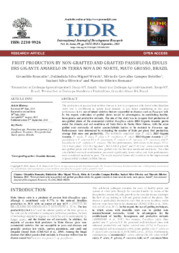Fruit production by non-grafted and grafted passiflora edulis brs gigante amarelo in terra nova do norte, Mato Grosso, Brazil.
Fruit production by non-grafted and grafted passiflora edulis brs gigante amarelo in terra nova do norte, Mato Grosso, Brazil.
Autoria: RONCATTO, G.; WRUCK, D. S. M.; BOTELHO, S. de C. C.; OLIVEIRA, S. S.; ROMANO, M. R.
Resumo: Abstract: The production of passion fruit in Mato Grosso is low in comparison with that of other Brazilian states and is insufficient to supply local demand. A key factor contributing to this poor performance is the use of mixed varieties that are susceptible to diseases such as Fusarium wilt. In this regard, cultivation of grafted plants would be advantageous in establishing healthy, homogenous and productive orchards. The aim of this study was to compare fruit production of non-grafted plants of the commercial cultivar Passiflora edulis BRS Gigante Amarelo grown under the climatic and soil conditions of Terra Nova do Norte, Mato Grosso, with the scion grafted onto rootstocks of native species/hybrids known to be resistant to Fusarium spp. Performances were determined by evaluating the number of fruits per plant, fruit production, average fruit mass and productivity. The rootstocks employed were P. edulis BRS Gigante Amarelo, P. nitida, P. alata, P. alata x P. maliformis, P. edulis BRS Gigante Amarelo x [(P. quadrifaria x P. setacea) F1 x P. incarnata], P. setacea x (P. speciosa x P. coccinea), and P. katsshbachu x (P. vitifolia x P. setacea). The best performances, with values in the ranges 183.6-232.8 fruits plant1, 33.5-39.2 kg plant-1, 165.8-190.9 g fruit-1 and 37-43 t ha-1, were observed with non-grafted plants and with the scion grafted onto the first four mentioned rootstocks. The other scion/hybrid rootstock combinations presented significantly lower values and their performances were considered moderate to poor. The results reported herein will contribute to the improvement of passion fruit orchards in Mato Grosso.
Ano de publicação: 2021
Tipo de publicação: Artigo de periódico
Unidade: Embrapa Agrossilvipastoril
Observações
1 - Por padrão são exibidas publicações dos últimos 20 anos. Para encontrar publicações mais antigas, configure o filtro ano de publicação, colocando o ano a partir do qual você deseja encontrar publicações. O filtro está na coluna da esquerda na busca acima.
2 - Para ler algumas publicações da Embrapa (apenas as que estão em formato ePub), é necessário ter, no celular ou computador, um desses softwares gratuitos. Sistemas Android: Google Play Livros; IOS: iBooks; Windows e Linux: software Calibre.
Acesse outras publicações
Acesse a Base de Dados da Pesquisa Agropecuária (BDPA) para consultar o acervo completo das bibliotecas da Embrapa.

